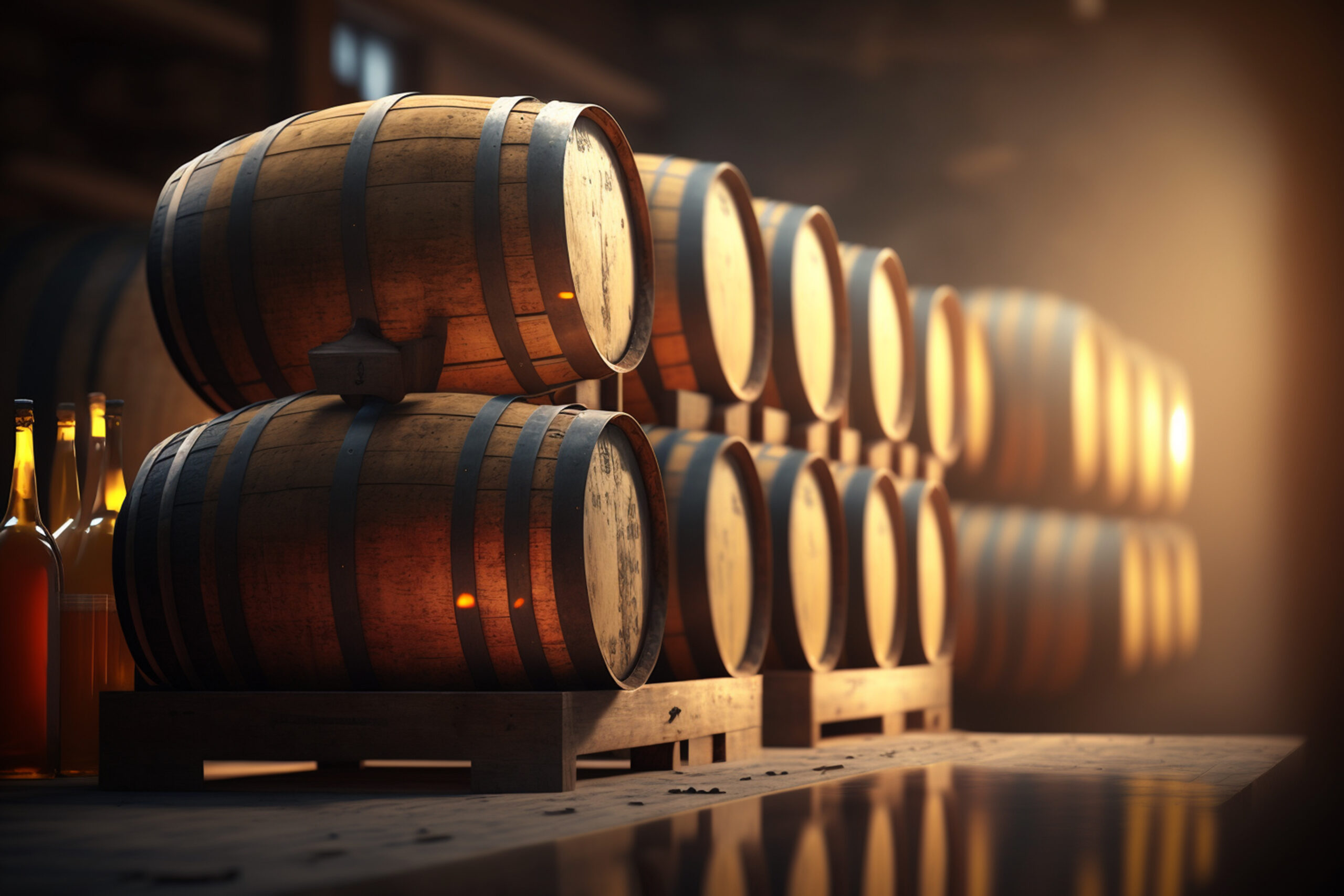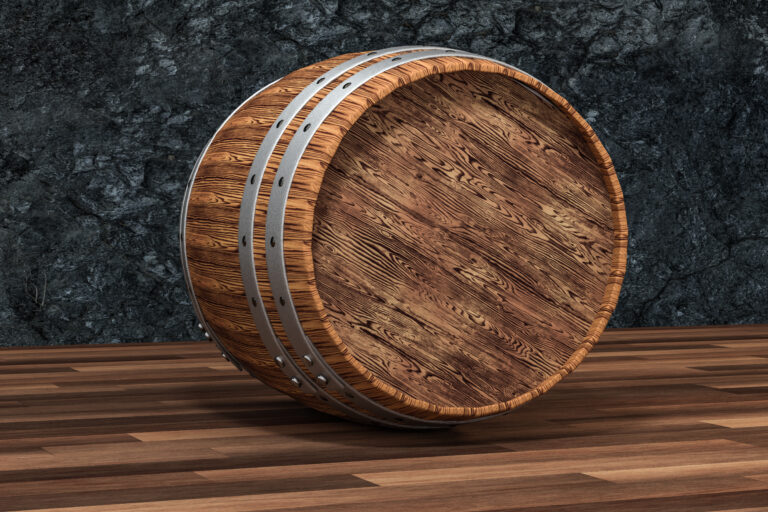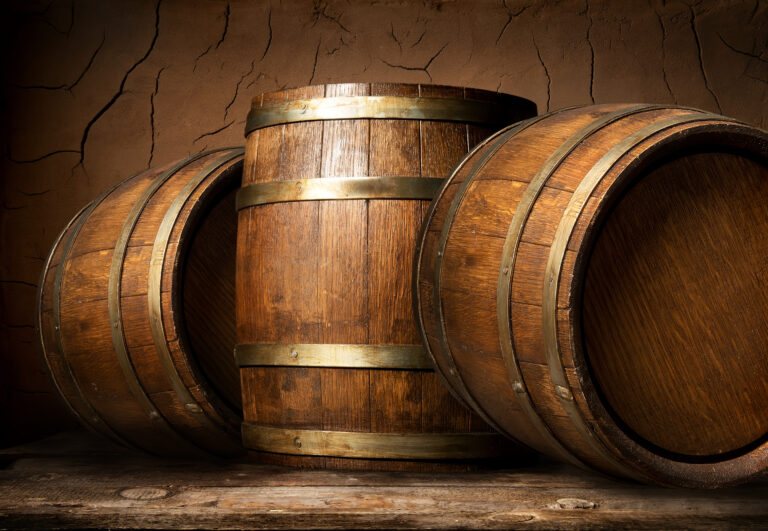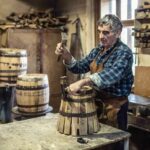Ever wondered why some of your favorite whiskeys hit you with delicious notes of coffee, chocolate, or even wine? The secret’s in the barrel! Distilleries often get creative, aging their whiskies in used barrels from wineries, breweries, and even other distillers. This clever trick infuses the spirit with incredibly complex flavors. You might be sipping a whiskey that spent years soaking up the essence of port, sherry, or even rum.
This practice of cross-industry barrel usage isn’t new; it’s been around for centuries and is a major reason behind the incredible diversity of whiskey flavors we enjoy today. As a whiskey lover, you’ve undoubtedly noticed just how much a barrel can influence the final taste. The type of wood, the level of charring, and what the barrel held previously all contribute to a magnificent blend of aromas and tastes that “seep” into the whiskey during aging.
So, the next time you pour yourself a dram, take a moment to consider its barrel’s backstory. Those lovely vanilla and caramel notes in your bourbon? They might just be a gift from an old rum or sherry cask. And that Scotch with its dried fruit and nutty flavors? Those could have originated in a former port pipe. Barrel aging is truly an art form, and these cross-industry barrels are the artist’s tools, shaping your whiskey’s unique character.
A Brief History of Whiskey Barrel Aging
The Origin of Barrel Aging
Believe it or not, barrel aging for whiskey started out of pure necessity. Distillers needed a way to transport their precious product without it evaporating or spoiling. Wooden barrels were the perfect solution. What they soon discovered was that the whiskey actually absorbed flavors and colors from the wood, significantly improving its taste during transportation and storage. This accidental discovery revolutionized whiskey production.
The Rise of Bourbon and Rye Whiskeys
In the late 1700s, whiskeys made from corn and rye began gaining popularity in Kentucky and Pennsylvania. The barrels used were often secondhand, having previously held and transported wine, rum, or other spirits. This clever barrel reuse imparted distinct flavors to these early bourbon and rye whiskeys. Over time, the practice of aging whiskey in used barrels from other industries became an integral part of their signature flavor profiles.
The Modern Whiskey Industry
Today, while most whiskeys are initially aged in charred new oak barrels, many distillers, especially craft distillers, still strategically use barrels from wineries or breweries to achieve specific flavor notes. For instance, a stout or port barrel can impart incredible chocolate or fruit flavors. This ongoing cross-industry barrel usage allows innovative craft distillers to create truly unique and complex whiskeys, reminiscent of the very origins of barrel-aged spirits.
Exploring whiskeys aged in diverse barrels is a fantastic way to experience the profound impact that oak alternatives have on flavor. You might just discover a new favorite that transcends traditional categories. Barrel aging is a fascinating blend of art and science, so here’s to the distillers who are constantly pushing boundaries with their wood experiments. Their creativity consistently produces delicious results that we all get to savor.
Why Does Barrel Aging Impact Flavor?
Barrel aging is where whiskey truly comes alive, developing the complex flavors we all adore. This magic happens through the continuous interaction between the spirit and the wood. As whiskey patiently sits in the barrel, it absorbs compounds from the wood, like vanillin, which is responsible for those distinctive tastes in aged whiskeys.
Why Oak Barrels?
Oak barrels, specifically those made from American or French oak, have traditionally been the preferred vessels for aging whiskey. Why oak? Well, oak contains chemicals called lignins that gradually break down over time and leach into the whiskey. These lignins are the source of those delightful vanilla, caramel, and toast flavors. Additionally, oak is porous enough to allow for some evaporation, which helps to concentrate the whiskey’s flavor over time.
The Impact of ‘Wet Wood’ and Toasting
New barrels, especially those with “wet wood” (meaning fresh wood with higher moisture content), tend to release more compounds, resulting in bolder wood flavors in the whiskey. Furthermore, the inside of barrels can be “toasted” by charring, which creates wonderful smoky, spicy flavors. The level of toasting, ranging from light to heavy char, directly determines how much flavor is imparted. Lighter toasting often produces subtle hints of vanilla and caramel, while heavier charring creates darker, more roasted flavors.
How Other Industries Use Barrels
It’s a beautiful cycle! Bourbon barrels are commonly reused for aging other spirits like rum, tequila, and Scotch, or for finishing craft beers. Wine barrels are also incredibly popular for whiskey finishing. These barrels infuse whiskeys with unique flavors from their previous contents – imagine tequila adding agave notes or wine lending fruity flavors. By using multiple barrel types, distillers can create complex, unique flavors that you simply won’t find in traditional single-barrel whiskeys.
The relationship between wood and whiskey is a partnership that has truly stood the test of time. By understanding how barrels impact flavor, you can better appreciate the intricate nuances of fine aged whiskeys. The continuous experimentation with different woods and toasts allows distillers to craft an incredible array of distinctive, memorable tastes.
How Other Industries Source Used Barrels for Whiskey Aging
The whiskey industry is constantly seeking innovative ways to add unique flavors to their spirits. One incredibly popular method is aging whiskey in used barrels from other industries, such as wine, rum, and brandy. These barrels subtly impart flavors from their previous contents, creating truly distinctive tasting notes in the finished whiskey.
Wine Barrels
Wine barrels, especially those that once aged robust red wines like Cabernet Sauvignon or Malbec, are highly coveted by whiskey distillers. The leftover wine residue in the wood imparts flavors of dark fruit, vanilla, and sometimes even a hint of tobacco to whiskeys aged in these barrels. You’ll find this influence in popular wine-barrel aged whiskeys like Maker’s Mark, Basil Hayden’s, and Knob Creek.
Rum Barrels
Rum barrels are known for contributing delightful tropical, sugary notes such as molasses, toffee, and banana. Rum-barrel aged whiskeys tend to be on the sweeter side. Brands like Whistlepig and Hudson frequently utilize used rum barrels to achieve these unique profiles.
Brandy Barrels
Brandy barrels lead to whiskeys with lovely stone fruit notes like apricot, peach, and cherry. They often also have a slight nutty character derived from the brandy. A fantastic example of a brandy-barrel aged whiskey is the Michter’s US*1 line.
Sherry Barrels
Sherry barrels, previously used to age sweet Sherry wines like Pedro Ximénez or Oloroso, create whiskeys with complex flavors of dried fruit, spice, and chocolate. Whiskeys aged in Oloroso sherry barrels, such as The Macallan, tend to be richer and nuttier. Pedro Ximénez barrels produce whiskeys with more pronounced raisin and fig notes.
Cross-industry barrel aging is a genuinely innovative approach for whiskey makers to craft spirits with truly distinctive flavor profiles. The sheer variety of barrels available allows distillers to produce unique, memorable tasting whiskeys. So, the next time you try a whiskey, try to detect notes from wine, rum, brandy, or sherry—it might just have been aged to perfection in a barrel from one of these fascinating industries.
Pros and Cons of Using Cross-Industry Barrels
Using barrels that previously held wine, spirits, or beer from different industries, also known as cross-industry barrels, offers some really interesting benefits and drawbacks for whiskey.
Pros
- Unique Flavor Infusion: Cross-industry barrels infuse the whiskey with genuinely unique flavors. The previous contents soak into the wood and interact with the whiskey, creating complex tastes that you simply won’t find in new barrels.
- Eco-Friendly Practice: It’s a fantastic eco-friendly practice that helps reduce waste. Reusing barrels is both sustainable and cost-effective for distilleries.
- Cult Following: The whiskey can develop a cult following due to its distinctive taste. Some distilleries have actually built their entire brand around the unique flavors imparted by cross-industry barrels.
Cons
- Flavor Control Challenges: There’s less control over the final flavor. Distillers can’t always perfectly predict how much the previous contents will influence the whiskey, which can lead to batch inconsistencies.
- Increased Preparation: These barrels require more rigorous cleaning and preparation. Distillers must ensure all previous contents are completely removed to avoid any off-flavors before the whiskey goes in.
- Risk of Overpowering Flavors: There’s a risk of the previous contents overpowering the whiskey. If not properly prepared, the barrel can make the whiskey taste more like its former occupant than the actual spirit.
- Unknown Provenance: The history and treatment of the barrels can sometimes be unknown. Without a trusted source, distillers can’t always confirm the barrels’ history or how they were prepared, potentially risking the quality of the whiskey.
- Legal Restrictions: In some regions, there are legal restrictions on which barrels can be used for aging whiskey. These regulations aim to maintain quality and prevent misleading consumers.
While using cross-industry barrels offers an exciting opportunity for innovation, it also comes with the risk of inconsistency. When implemented properly, with high-quality barrels and close monitoring, cross-industry barrels can yield truly distinctive, premium whiskeys. However, distillers must exercise caution to ensure the previous contents enhance, rather than define, the final flavor.
Popular Cross-Industry Barrels Used for Whiskey
Whiskey makers are constantly experimenting with different barrels to age their spirits in, as the wood is paramount in imparting flavor during maturation. Here are some of the most popular cross-industry barrels they use:
Wine Barrels
Aging whiskey in used wine barrels, especially those that held robust red wine, gives the whiskey subtle hints of its vinous past. The wine’s flavor compounds seep into the wood and then, beautifully, into the whiskey. Wine barrel-aged whiskey often features notes of dried fruit, spice, and oak. Popular types include Cabernet, Merlot, and Port barrels.
Rum Barrels
Rum barrels are champions at imparting tropical, caramel-like flavors to whiskey. The rum’s molasses and brown sugar notes are absorbed by the wood and transferred to the whiskey during aging. You’ll often find rum barrel-finished whiskey with hints of vanilla, cocoa, and coconut.
Sherry Barrels
Aging whiskey in sherry barrels results in a wonderfully fruity, nutty spirit. The sherry’s flavors of raisins, prunes, almonds, and warm spice truly shine through in the whiskey. Whiskeys aged in Oloroso sherry barrels tend to be darker, richer, and fruitier than those aged in fino or amontillado barrels.
Port Barrels
Port barrel-aged whiskeys take on delightful notes of dried fruit like raisins, figs, and prunes, along with nutty, chocolatey flavors from the port. The sweet, fortified wine’s flavors are beautifully imparted to the whiskey during maturation, resulting in a fruity, almost dessert-like profile.
Tequila Barrels
Used tequila barrels can give whiskey an exciting agave-inspired kick and a subtle chili pepper spice. The tequila’s peppery, vegetal, and mineral qualities make their way into the whiskey, creating an unusual but fascinating fusion of flavors. Tequila barrel-finished whiskey has been described as having notes of vanilla, honey, jalapeño, and lime zest.
Whiskey makers are always innovating, trying different barrel finishes to create unique, complex flavors in their spirits. Cross-industry barrel aging is an exciting frontier for distillers to experiment and for whiskey lovers to discover truly new tastes. What kind of barrel influence do you want to try next?
How Wine Barrels Impact Whiskey Flavor
Wine barrels have been used for centuries to age and flavor whiskey. As the whiskey patiently interacts with the wood, it absorbs compounds that significantly impact its aroma, taste, and color. The type of wood, the barrel size, and whether it previously held wine all play crucial roles in determining how much flavor is imparted.
French Oak
French oak barrels are a popular choice for aging whiskey. French oak contributes delightful flavors of vanilla, spice, and dried fruit. Bourbon, for example, often acquires its distinctive sweet, smoky flavor partly from charred French oak.
Port and Sherry Barrels
Barrels that previously aged port or sherry wines are treasure troves, imparting wonderful raisin, nut, and chocolate notes. The leftover wine residue cleverly interacts with the whiskey, resulting in a fruity, full-bodied flavor profile. These are particularly popular for aging Scotch whiskies.
Wine Barrel Sizes
The most common wine barrel sizes used for whiskey are hogsheads (approximately 250 liters) and butts (around 500 liters). Generally, larger barrels mean more surface area contact with the wood, leading to faster aging and more pronounced oak flavors. Smaller barrels, conversely, can accelerate aging and increase the overall wood influence.
Blending Barrel-Aged Whiskeys
Master distillers are true artists, often blending multiple barrel-aged whiskeys to create a perfectly balanced, complex flavor profile. By blending whiskies aged in different types of barrels and for varying lengths of time, distillers can craft a bespoke, signature taste.
The timeless practice of barrel aging remains an integral part of crafting fine whiskey. As distillers continue to experiment with alternative barrel types, such as rum, tequila, and brandy casks, the incredible variety of flavors achieved through barrel aging will only continue to grow. The impact of these cross-industry barrels on whiskey flavors is an exciting new frontier for both whiskey makers and aficionados alike.
How Rum Barrels Impact Whiskey Flavor
Rum barrels are frequently used to age whiskey after its initial maturation in charred new oak casks. These rum barrels impart truly distinctive tropical, molasses, and brown sugar flavors to the whiskey.
Complex Caramel Notes
Since the rum barrels previously held molasses-based rum, they naturally impart rich, caramel-like flavors to the whiskey. Tasting notes often describe rums as having butterscotch, toffee, or treacle (molasses) aromas, and these are beautifully transferred to the whiskey during maturation. The whiskey absorbs these complex sugars and develops its own rich, dark caramel character.
Tropical Fruit Accents
In addition to the wonderful caramel flavors, rum barrels generously contribute tropical fruit accents to whiskey. It’s not uncommon to find banana, coconut, pineapple, or mango aromas. These delightful fruity esters develop during rum fermentation and aging, and they come through clearly in the final whiskey. The combination of dark caramel and bright tropical fruit is a true hallmark of rum barrel-aged whiskey.
Lingering Molasses Finish
One of the most distinctive characteristics of rum barrel-matured whiskey is its long, molasses-infused finish. The molasses and brown sugar flavors that build up in the rum barrels during aging are imparted to the whiskey, coating the palate with each sip. The finish seems to go on forever, with waves of molasses, burnt sugar, and spice that linger long after swallowing.
Enhanced Oak Influence
While rum barrels certainly contribute distinctive flavors to whiskey, they also beautifully enhance traditional oak aging characteristics like vanilla, clove, and cinnamon spice. The combination of rum barrel flavors and traditional oak spices creates extra layers of richness and complexity in the final spirit. Rum barrel aging truly offers the best of both worlds: tropical brightness and classic oak depth, all in one unique spirit.
In short, rum barrels remarkably transform whiskey by adding delightful molasses, brown sugar, and tropical fruit flavors. A rum barrel-aged whiskey has a character all its own, with a perfect balance of dark sugars, bright esters, and oak spice that could only come from this unique marriage of barrel and spirit. It’s no wonder rum barrel-finished whiskeys have become so incredibly popular!
How the Source Barrel’s Contents Affect Whiskey
The type of barrel used to age whiskey has a profound impact on its resulting flavor. Barrels that previously held wine, rum, or other spirits impart unique notes of their former contents to the whiskey.
Wine Barrels
Whiskey aged in used wine barrels, especially those that previously held rich red wines like Cabernet Sauvignon or Merlot, takes on lovely hints of fruit and oak. The wine’s tannins and flavors seep into the wood, later subtly influencing the whiskey. You might detect notes of black cherry, raspberry, or currant in the whiskey, with the oak also providing subtle spice flavors.
Rum Barrels
Rum barrels are masters at imparting tropical flavors to whiskey, such as banana, coconut, and molasses. The rum’s sugary compounds permeate the wood, giving the whiskey a delightful smoothness and sweetness. Rum barrels are frequently used to age bourbon, rye, or Tennessee whiskey.
Sherry Barrels
Barrels that previously held Oloroso or Pedro Ximénez sherries contribute wonderful dried fruit flavors like raisins, prunes, and apricots to whiskey. Nutty, woody notes are also quite common. The sherry’s oxidized grapes and blend of grape varieties infuse the wood with concentrated, syrupy flavors that translate beautifully to whiskey.
Multiple Barrels
Some distillers elevate their craft by using a combination of different barrels to age their whiskey. This allows them to create incredibly complex, layered flavors in the final product. The whiskey might spend time in wine, rum, and sherry casks, picking up a medley of fruit, spice, and oak notes from each barrel. Blending whiskeys from different barrels is an art form that expert distillers have truly perfected.
The source of a barrel has a profound impact on the aroma, taste, mouthfeel, and finish of the whiskey. Distillers meticulously choose barrels to produce the exact flavor profile they desire in their whiskey. Trying different whiskeys aged in various barrels is a fantastic way to experience firsthand how wood type affects the spirit.
The Future of Cross-Industry Barrel Aging for Whiskey
The whiskey industry is always evolving, and the ingenious use of barrels from different industries is continuously shaping exciting new flavors. As distillers continue to experiment, we’re sure to see even more innovative aging processes and intriguing taste profiles emerge.
Exploring New Wood Types
Distillers are bravely expanding beyond the traditional oak barrel, trying out different wood types like hickory, cherry, and maple. These diverse woods impart distinct flavors that offer an interesting twist on classic whiskeys. Small craft distillers, in particular, are at the forefront of testing out these alternative woods.
Blending Barrel Influences
Some distillers are taking things a step further, aging their whiskeys in used barrels from the wine, beer, and sherry industries to craft truly unique flavor profiles. The leftover traces of these spirits and wines in the wood barrels subtly seep into the whiskey during aging, creating complex taste combinations. Blended barrel aging is an exciting area of experimentation that will undoubtedly continue to drive innovation.
Finishing in Different Barrels
After initial aging in new charred oak barrels, many distillers are “finishing” their whiskeys in used barrels from other industries. Finishing for just a few months in a port or sherry cask, for example, can significantly alter the flavor profile by imparting delightful fruity or nutty notes. Finishing in used barrels is an accessible way for distillers to create distinctly tasting whiskeys without straying too far from tradition.
The New Era of Barrel-Aged Whiskey
While regulations still limit some aspects of barrel usage for commercial whiskey, the rise of small craft distillers is ushering in an exciting new era of experimentation. As consumers increasingly seek out unique and flavorful whiskey experiences, cross-industry barrel aging and other innovative techniques will shape the very future of whiskey. The possibilities for aging whiskey are truly endless, limited only by the creativity of distillers and the receptiveness of whiskey drinkers to new tastes and aromas. The future of barrel-aged whiskey is indeed incredibly exciting!
Final Thoughts
So, there you have it! The barrels used to age whiskey have an immense impact on the final flavor, aroma, and color. By cleverly reusing barrels from wine, sherry, and bourbon production, distillers have discovered an ingenious and cost-effective way to impart complex flavors into their spirits. The interaction between the wood and the whiskey creates a kind of alchemy, producing tantalizing tastes of vanilla, spice, fruit, and nuts.
The next time you nose a glass of whiskey, take a moment to truly think about the barrel it aged in and the incredible story behind where it came from. There’s a whole world of flavors to explore, and it’s all thanks to the humble barrel. Whiskey is truly liquid history, so raise your glass and appreciate each complex sip. What new barrel-aged whiskey will you discover next?







